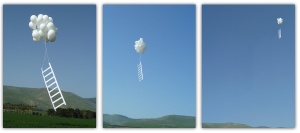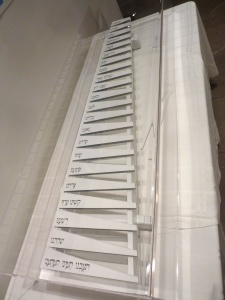Off Label: Dov Abramson & Ken Goldman
After the shock of recognition that the artists are speaking our language, but with a slightly different accent, the well-informed observant audience will recognize that a serious thought-provoking Jewish art can easily also put a smile on your face. This is what is now being offered at the JCC in Manhattan with Off Label: Dov Abramson & Ken Goldman until July 30, 2014.

Goldman’s (kengoldmanart.com) work is bifurcated between wild celebration and feeling terribly constricted by Jewish practice. With Without meditates on the all but universal practice of Ashkenazi males covering their heads with a kippah or some other head covering at all times. But what happens when by some unforeseen circumstance no head covering is available. Is one perforce “naked”? Or does a “ghost kippah” of your own hair grow in its place, like shown in the exhibition photo? The idea that the halacha/minhag is so overwhelming that it would cause the body to comply expresses a fundamental discomfort and rebellion with the force of this traditional Jewish practice.
Kaddish Zuger affectionately reflects on the practice of lighting an annual memorial candle and saying kaddish for a deceased parent. Such a nice practice, year in, year out. But, oh the guilt if one forgets, misses a minyan or doesn’t light a candle! Picture the dutiful son, a thick white candle atop his head with wax drippings encrusting his head and dribbling down the back of his neck and shoulders. The force of observance threatens to obliterate the very real feelings of filial devotion and affection. Similarly, Siyag delineates the entire halachic universe as an oversized Elizabethan collar. All 248 positive mitzvoth are written on the inside of the Plexiglas collar while all 365 negative mitzvoth are inscribed on the outside. The collar fits all too well, expresses our devotion to fulfilling God’s will; and yet suffocates, constrains and cripples our every movement.
Of course this is not the whole picture. An entire other portion of Goldman’s work is an exuberant, idiosyncratic celebration of Jewish practice. Stamped records the physical effect of binding tefillin on one’s arm, the lines the straps make, explicated with the Hebrew verse, “and you shall bind them as a sign” similarly imprinted in the flesh. In this photograph of the 2012 performance the verse normally hidden in the boxes becomes explicit as part of the act of binding as public sign upon the male body.
The sheer affection with which Jews do mitzvoth is expressed “In God’s Image.” The video the starts with the letter “shin,” representative of the mezuzah on all Jewish doorposts, followed by close-ups of lips puckering up to plant a kiss on the virtual mezuzah. One after the other, male and female, they express love of the Divine commandment of mezuzah. The kissing trope is taken to its logical conclusion with Kissed Torah Cover, a white satin Torah mantle neatly covered with lipstick kisses, “a celebration of kisses which never reach the Torah,” presumably because of the strictures of the mehitzah. Here an expression of Jewish practice (i.e. strictly enforced mehitzah) is circumvented by exuberant affection for the Torah itself.

Exuberance is the hallmark of Jacob’s Ladder, a 2011 performance piece that features a 8 rung white ladder lifted aloft by a cluster of white helium balloons above Israeli fields. Referencing the substance of the Jacob’s Ladder narrative, here (as in the text) the ladder becomes the means of transmission between the human and Divine. Just as Jacob’s dream envisioned the divine messengers connecting and communicating with the mundane, so too Goldman’s sublime ladder floating up into the blue sky represents the yearning of our prayers ascending to supernal realms.
Dov Abramson’s (studiodov.com) work, Ner Mitzvah (2003), 613 yahrzeit candles with custom labels, seen both in the Jewish Museum New York and the Israel Museum, was a meditation on the repetitively challenging nature of ritual performance, and an implicit invitation to imagine performing many mitzvoth, or perhaps all 613, as easily as lighting a yahrzeit candle. His work here at the JCC continues these ideas on multiplicity to a surprising conclusion. Please Put Us Back In One Peace features five black boxes as small suitcases, each with two depictions of the dangers of traveling (animals, bandits, ambush, etc.) enumerated in the Wayfarer’s Prayer. Perhaps such multiple totems might work towards assuaging fears of flying and other roadside dangers. The daily question, “Do We Have a Minyan?” could be more easily answered if those 10 pictured here were equally countable. But traditional practice makes distinctions between child and adult, male and female; in spite of the universalist implication in the much used counting verse; “Hoshiya et amecha…”(Psalm 28:9) that each person holds as a mini-protest.

Abramson’s ZMaN NaKaT is counting at its simplest. The six orders of Mishnayot depicted in 6 handsome posters are paragons of clever, succinct, industrial design. Subtle symbols of each tractate are embedded within and around a bold single image for each order; Zeraim (Seeds) is a tractor; Moed (Festival) is an hourglass; Nashim (Women) is a heart; Nezikin (Damages) is a bull; Kodashim (Holy Things) is the altar; and Tehorot (Purity) is a tent.
The white xylophone is different. Vidduy: The Musical breaks through the formidable barrier of repetitive confession to allow us to begin to understand what is at the heart of this fundamental religious act. The 22 pure white keys are inscribed with the “Vidduy Zuta” (Small Confession) repeated by some daily, and intoned by all seemingly countless times on Yom Kippur. As the core of the Jewish confessional act these words reverberate with all our emotions of sin and repentance; our shame, humility and hope of reaching out to God. Abramson’s vidduy xylophone teaches us that our pleas are heard by the Almighty as music, within the melody of our relationship to our Creator. It recognizes that music is a powerful spiritual communicator; much like Serach sang to Jacob, piercing his anguished consciousness to tell him his son Joseph was alive. In our sin, we were lost; in our confession carried by music, we are now found by God.
Ken Goldman and Dov Abramson brilliantly plumb the many uses of “Off Label”, i.e. unapproved use, for a host of Jewish ritual objects and concepts. Each has an individual vision that sees received tradition as deeply worthy of close examination, deconstruction and appropriation to be cherished anew.
Off Label: Ceremonial Objects Imagined: Dov Abramson & Ken Goldman
The JCC in Manhattan
334 Amsterdam Avenue at 76th Street: Laurie M. Tisch Gallery
Mon – Thurs 5:30am – 10:30pm; Friday, 5:30am – 9:30pm; Sat. 7am – 9:30pm;
Sun 7am – 9:30pm
Through July 30, 2014 – www.jccmanhattan.org – 646 – 505 5708

